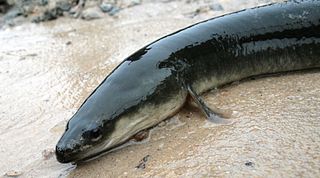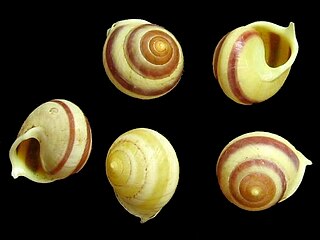
The American eel is a facultative catadromous fish found on the eastern coast of North America. Freshwater eels are fish belonging to the elopomorph superorder, a group of phylogenetically ancient teleosts. The American eel has a slender, supple, snake-like body that is covered with a mucus layer, which makes the eel appear to be naked and slimy despite the presence of minute scales. A long dorsal fin runs from the middle of the back and is continuous with a similar ventral fin. Pelvic fins are absent, and relatively small pectoral fins can be found near the midline, followed by the head and gill covers. Variations exist in coloration, from olive green, brown shading to greenish-yellow and light gray or white on the belly. Eels from clear water are often lighter than those from dark, tannic acid streams.

A salp or salpa is a barrel-shaped, planktonic tunicate in the family Salpidae. It moves by contracting, thereby pumping water through its gelatinous body; it is one of the most efficient examples of jet propulsion in the animal kingdom. The salp strains the pumped water through its internal feeding filters, feeding on phytoplankton.

The Bahama yellowthroat is a New World warbler. It is a resident breeder endemic to the Bahamas.
Rhinella rostrata, also known as the Mesopotamia beaked toad, is a species of toad endemic to Colombia. It is only known from its type locality near the village of Mesopotamia, on the western slope of the Cordillera Occidental in the south of the Antioquia Department.

Bembix rostrata is a species of sand wasp native to Central Europe. The genus Bembix - of which B. rostrata is among the most distinctive species - has over 340 species worldwide and is found mostly in warm regions with open, sandy soils; Australia and Africa have a particularly rich variety of species.
NVC community M4 is one of the mire communities in the British National Vegetation Classification system.
Bolitoglossa rostrata is a species of salamander in the family Plethodontidae. It is found in Guatemala and Mexico. Its natural habitats are subtropical or tropical moist montane forests and heavily degraded former forest. It is threatened by habitat loss.

The Tahiti petrel is a medium-sized, dark brown and white seabird found across the Pacific Ocean. The species comprises two subspecies: P. r. rostrata which breeds in the west-central Pacific Ocean, and P. r. trouessarti which breeds in the tropical and subtropical Pacific Ocean. The Tahiti petrel belongs to the Procellariidae family and is the most studied member of the Pseudobulweria genus which comprises three critically endangered species. Similarly, the Tahiti petrel is considered near threatened by the 2018 IUCN Red List of Threatened Species. Threats include introduced rats, feral cats, pigs, dogs, nickel mining, and light pollution.

Yucca rostrata also called beaked yucca, is a tree-like plant belonging to the genus Yucca. The species is native to Texas, and the Chihuahua and Coahuila regions of Mexico. This species of Yucca occurs in areas that are arid with little annual rainfall.

Helicina rostrata is a species of tropical land snail with an operculum, a terrestrial gastropod mollusc in the family Helicinidae.

Carex rostrata, the bottle sedge or beaked sedge, is a perennial species of sedge in the family Cyperaceae.

Canthigaster rostrata, commonly known as the Caribbean sharp-nose puffer, is a pufferfish from the Western Central Atlantic. The Caribbean sharp-nose puffer is a small fish with a maximum length of 12 cm or approximately 4.7 inches. It can be encountered from the coast of South Carolina to Venezuela, including Bermuda, the Gulf of Mexico, and in the Caribbean Sea. They can live up to 10 years in the wild, females typically live longer due to aggressive male territory behavior. The Caribbean sharp-nose puffer is a highly toxic species of marine fish due to the presence of tetrodotoxin in its tissues and organs. Despite its toxicity, the sharp-nose pufferfish occasionally makes its way into the aquarium trade.

Rostratus (masculine), rostrata (feminine) or rostratum (neuter) is a Latin adjective meaning "beaked, curved, hooked, with a crooked point, or with a curved front".

The eastern shovelnose ray is a species of guitarfish in the family Rhinobatidae of order Rhinopristiformes. The species is endemic to the east coast of Australia and inhabits subtropical and temperate waters from southern Queensland to southern New South Wales.
Melicope rostrata, synonym Platydesma rostrata, is a rare species of flowering plant in the citrus family, known by the common name pilo kea lau li'i. It is endemic to Hawaii, where there are only about 100 individuals remaining on island of Kauai. It was federally listed as an endangered species of the United States in 2010.

Parvilucifera is a genus of marine alveolates that behave as endoparasites of dinoflagellates. It was described in 1999 by biologists Fredrik Norén and Øjvind Moestrup, who identified the genus among collections of Dinophysis dinoflagellates off the coast of Sweden. Initially mistaken for products of sexual reproduction, the round bodies found within these collections were eventually recognized as sporangia, spherical structures that generate zoospores of a parasitic protist. This organism was later identified as P. infectans, the type species. The examination of this organism and its close genetic relationship to Perkinsus led to the creation of the Perkinsozoa phylum within the Alveolata group.

Macropodia rostrata, common names, the common spider crab, long-legged spider crab, long-legged crab, is a species of marine crab in the family Inachidae. The Macropodia Rostrata visually mimics many other types of small crabs with the exception of its long legs. By attaching algae to their thin legs, they can be confused with the stem of seaweed. This is both a defense mechanism and a predatory advantage, as unsuspecting fish will hide in seaweed beds from nearby predators. This behavior can be absent among larger crabs, and those that live at great depths like giant Japanese spider crabs.

Dacryodes rostrata is a tree in the family Burseraceae. The specific epithet rostrata is from the Latin meaning 'beaked', referring to the narrow-tipped leaves.
Cyvirus anguillidallo1, also known as Anguillid herpesvirus 1 (AngHV-1) is a species of virus in the genus Cyprinivirus, family Alloherpesviridae, and order Herpesvirales.
Brooksia berneri is a species of Salpida in the family Salpidae.













